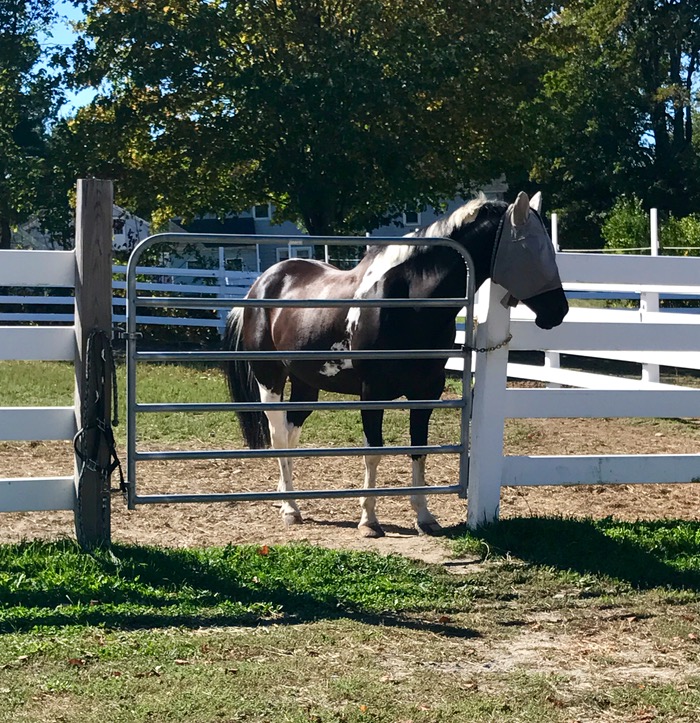It’s the small courtesies that make life pleasant. Someone holds a door for you as you enter a shop. A driver at an intersection stops to let you safely cross the road. In a crowded supermarket, you move your cart over to let another pass. These little things add up.
At a stable there are plenty of opportunities for small courtesies, too, between you and your horse. The horse stands quietly while the halter is put on, and you do it in a way that is gentle and includes a scratch in a favored place. (The impolite version of this is a horse that lifts his head out of reach.) You let the horse know that you’re walking around him in the stall and he moves over. (Much nicer than getting squished between a horse butt and the wall.) You take your horse out of the paddock and you let him graze a moment, and then he willingly leaves the grass when asked to walk with you to the barn. (We’ve all been dragged around by horses who go where they want to, irregardless of how much one tugs on the lead rope.) All of these polite behaviors must be taught. And yet, so many people expect that the horse should just do these things, and when the horses don’t, they get annoyed. People pull, push, hit, and yank, when a little bit of training would create pleasant interactions.
Here’s an example. Tonka presses eagerly at the fence when he sees me.

I can’t just open it up to say hello. I have to undo the chain, which is difficult to do with a 1,000 pound horse leaning into the gate. Also, there’s a chance he’ll barge past me to the grass, or worse, spook and take off before I have a lead on him. So, I’ve taught Tonka to back up on a verbal cue. That gives me space to enter and handle him safely.
A little courtesy makes the world so much more pleasant.
What polite behaviors have you taught your horse?


We always pause coming through any gate so there is the habit of no rushing through. I also ask them to please step back and wait when food being served. Thank you for sharing with us. Hope you are healing well.
I’m sure that your horses are more relaxed knowing what’s expected and what comes next. Rushing, barging, horses don’t look happy, do they? Manners make everyone happier!
My one mare I’ve had since she was born, she has very good ground manners. I’ve taught her “head down”, back, and etc. on voice que or by body language. It always surprises me when I lead someone else’s horse and they pull or walk ahead of me or whatever. The other two are still a work in progress. My gelding is really bad about wanting to be the first one out at the gate, I need to work on that.
When a horse has emotional issues wrapped around a behavior, it can take more effort to train. Sometimes you can figure out a way to manage the environment so it’s not as challenging.
The most important behavior that I have taught my horse is to “wait” on command, and then the release of “okay”. Whether he is leaving the paddock, entering his stall or leaving the cross ties after being tacked up, he knows that he can’t rush around me.
Great idea! A universal skill that can be used anywhere. What happens when we train such things is twofold – first is the behavior itself. Second is that we become more clear in our minds about what we want the horse to do, and so behave around the horse with more clarity.
Kim, good idea, I’ve taught that to the gelding we acquired with the anxiety problems, Extremely dangerous putting him in or out of a stall, he now knows the wait command and the OK command, coming out or going in, or leading him. All my horses know that, he was a big problem though. Maybe I can use that to stop him crowding around at the gate. Thanks for giving me an idea.
Thank you Terry for another great post. I’ve taught my eventing mare April to hold her hoof on an upside-down bucket while I clean her stud holes and install the studs before stadium or cross country jumping. This saves my back (she’s a big girl) and keeps her in one spot. A “good girl” after each leg is done lets her know I’m pleased. She also responds to “move over” in the cross ties with one or more steps, which is very convenient!
We are working on self-loading onto the trailer: I show her I’m putting her reward in the manger and walk up the ramp next to her. She usually skips right up.
Looking forward to your next installment!
Brilliant idea with the studs! Saves your back – and keeps the breeches clean 🙂 Self-loading is an essential skill. While you’re working on that, make sure that your body language leading up to the loading is consistent. When I flip the lead rope over Tonka’s neck, he knows to start marching on. I do it the same way every time and it’s become a cue. If you can do that before putting the treat in, then eventually you can fade the treat part. In an emergency, you’ll want to have the behavior that clean.